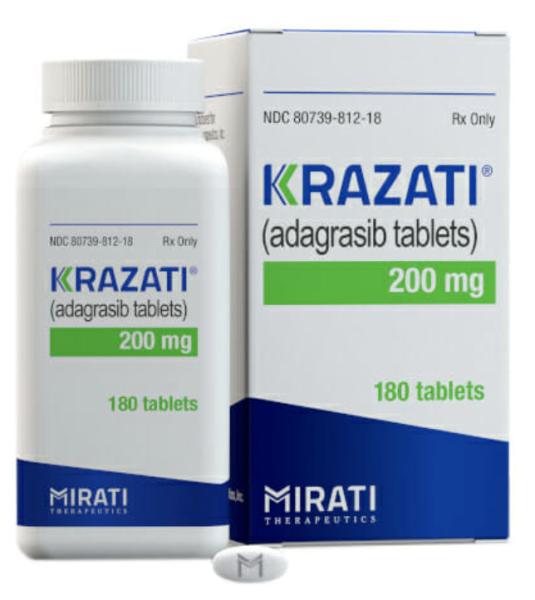Adagrasib Side Effects
Medically reviewed by Drugs.com. Last updated on May 6, 2023.
Applies to adagrasib: oral tablet.
Serious side effects of Adagrasib
Along with its needed effects, adagrasib may cause some unwanted effects. Although not all of these side effects may occur, if they do occur they may need medical attention.
Check with your doctor immediately if any of the following side effects occur while taking adagrasib:
More common
- Agitation
- bloody urine
- bone pain
- chest pain, discomfort, or tightness
- coma
- confusion
- constipation
- cough
- dark urine
- decreased amount of urine
- depression
- diarrhea
- dizziness
- fainting
- fast heartbeat
- fever or chills
- headache
- hostility
- increased blood pressure
- increased thirst
- irregular or slow heart rate
- irritability
- lethargy
- lightheadedness
- loss of appetite
- lower back or side pain
- muscle twitching
- nausea
- rapid, shallow breathing
- seizures
- sneezing
- sore throat
- stomach pain, severe
- stupor
- swelling
- swelling of the face, fingers, or lower legs
- trouble breathing
- unusual tiredness or weakness
- vomiting
- weight gain
- yellow eyes or skin
Less common
- Anxiety
- blue lips, fingernails, or skin
- blurred vision
- coughing up blood
- decreased appetite
- decreased urination
- decreased weight
- dilated neck veins
- dizziness, faintness, or lightheadedness when getting up suddenly from a lying or sitting position
- dry mouth
- muscle pain or cramps
- nightmares or unusually vivid dreams
- pale skin
- sunken eyes
- sweating
- unusual bleeding or bruising
- wrinkled skin
Rare
- Inability to speak
- slurred speech
- stiffness
- temporary blindness
- weakness in the arm or legs on one side of the body, sudden and severe
Incidence not known
- General feeling of discomfort or illness
- thickening of bronchial secretions
For Healthcare Professionals
Applies to adagrasib: oral tablet.
Cardiovascular
Very common (10% or more): Electrocardiogram QT prolonged (20%)
Common (1% to 10%): Cardiac failure, hypotension
Uncommon (0.1% to 1%): Decreased ejection fraction, hemorrhage[Ref]
Gastrointestinal
Very common (10% or more): Diarrhea (70%), nausea (70%), vomiting (57%), constipation (22%), abdominal pain (21%), increased lipase (35%)
Uncommon (0.1% to 1%): Gastrointestinal obstruction
Frequency not reported: Increased amylase[Ref]
General
The most common adverse reactions with a frequency of 25% or greater were nausea (70%), diarrhea (69%), vomiting (57%), fatigue (55%), musculoskeletal pain (38%), hepatotoxicity (37%), renal impairment (33%), edema (30%), dyspnea (26%), and decreased appetite (29%).
The most common Grade 3 or 4 laboratory abnormalities with a frequency of 2% or greater were decreased lymphocytes (20%), decreased sodium (52%), decreased hemoglobin (51%), increased alanine aminotransferase (4.5%), increased aspartate aminotransferase (4.2%), hypokalemia (3.6%), hyponatremia (3.4%), increased lipase (2.5%), decreased leukocytes (2.5%), decreased neutrophils (2.3%), and increased alkaline phosphatase (2.0%).[Ref]
Hematologic
Very common (10% or more): Decreased lymphocytes (64%), decreased hemoglobin (51%), decreased platelets (27%)
Common (1% to 10%): Anemia, decreased leukocytes, decreased neutrophils[Ref]
Metabolic
Very common (10% or more): Decreased appetite (30%)
Common (1% to 10%): Hyponatremia, dehydration, hypokalemia[Ref]
Musculoskeletal
Very common (10% or more): Musculoskeletal pain (41%)
Common (1% to 10%): Muscular weakness[Ref]
Nervous system
Very common (10% or more): Dizziness (23%)
Common (1% to 10%): Cerebrovascular accident
Uncommon (0.1% to 1%): Encephalitis[Ref]
Other
Very common (10% or more): Fatigue (59%), edema (32%), decreased sodium (52%), decreased albumin (50%), decreased magnesium (26%), decreased potassium (26%)
Common (1% to 10%): Sudden death, sepsis, pyrexia, increased alkaline phosphatase
Frequency not reported: Decreased weight[Ref]
Psychiatric
Common (1% to 10%): Mental status changes[Ref]
Renal
Renal impairment includes acute kidney injury and increased blood creatinine.[Ref]
Very common (10% or more): Renal impairment (36%), increased creatinine (50%)[Ref]
Respiratory
Very common (10% or more): Dyspnea (35%), cough (24%), pneumonia (24%)
Common (1% to 10%): Hypoxia, pleural effusion, respiratory failure
Uncommon (0.1% to 1%): Pulmonary embolism, pulmonary hemorrhage, pneumonitis[Ref]
Hepatic
Hepatotoxicity includes, mixed liver injury, increased blood alkaline phosphatase, increased alanine aminotransferase, increased aspartate aminotransferase, increased liver function test, increased blood bilirubin, and increased conjugated bilirubin.[Ref]
Very common (10% or more): Hepatotoxicity (37%), increased aspartate aminotransferase (52%), increased alanine aminotransferase (46%)[Ref]
More about adagrasib
- Check interactions
- Compare alternatives
- Dosage information
- During pregnancy
- Drug class: miscellaneous antineoplastics
- En español
Patient resources
Other brands
Professional resources
Other brands
Related treatment guides
References
1. Product Information. Krazati (adagrasib). Mirati Therapeutics, Inc. 2022.
Further information
Always consult your healthcare provider to ensure the information displayed on this page applies to your personal circumstances.
Some side effects may not be reported. You may report them to the FDA.

